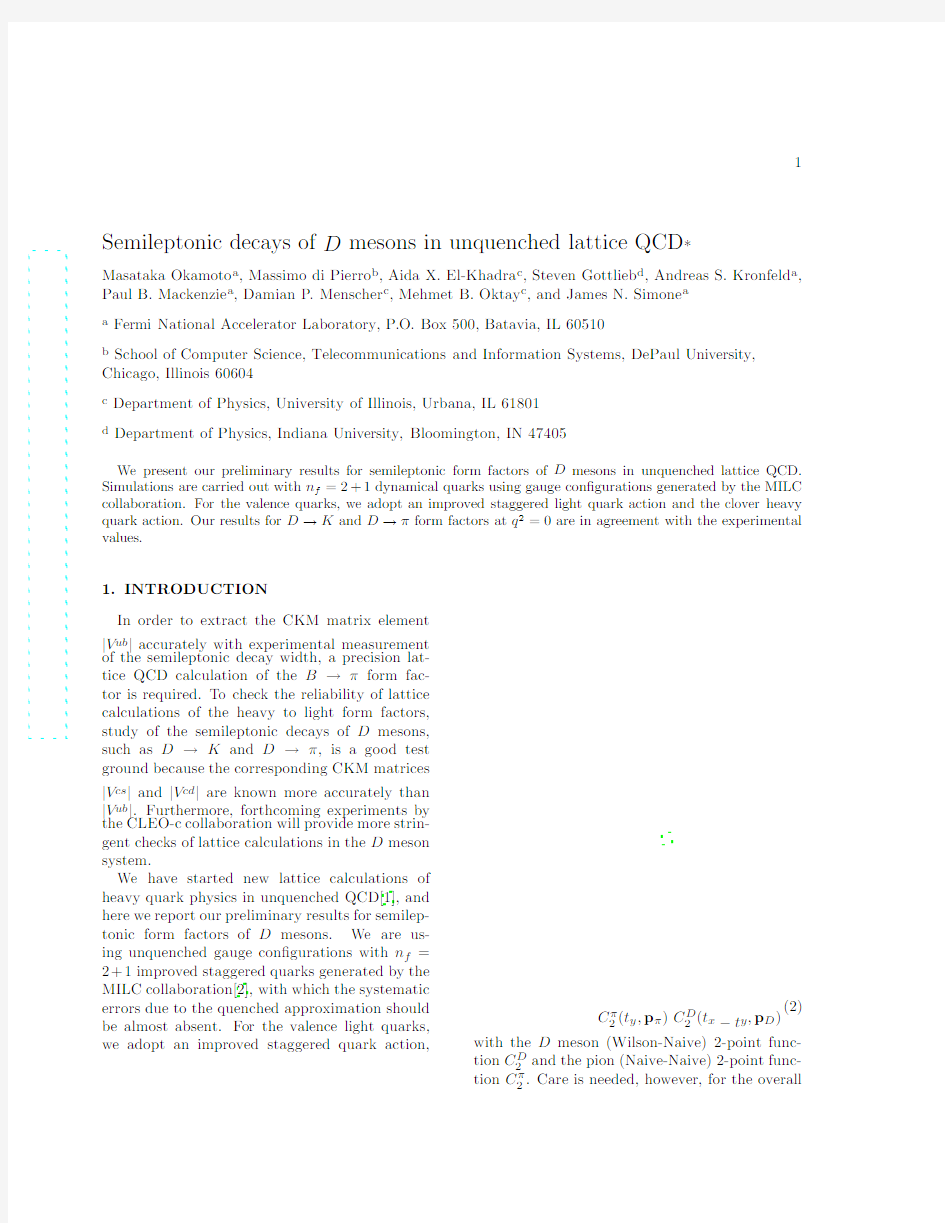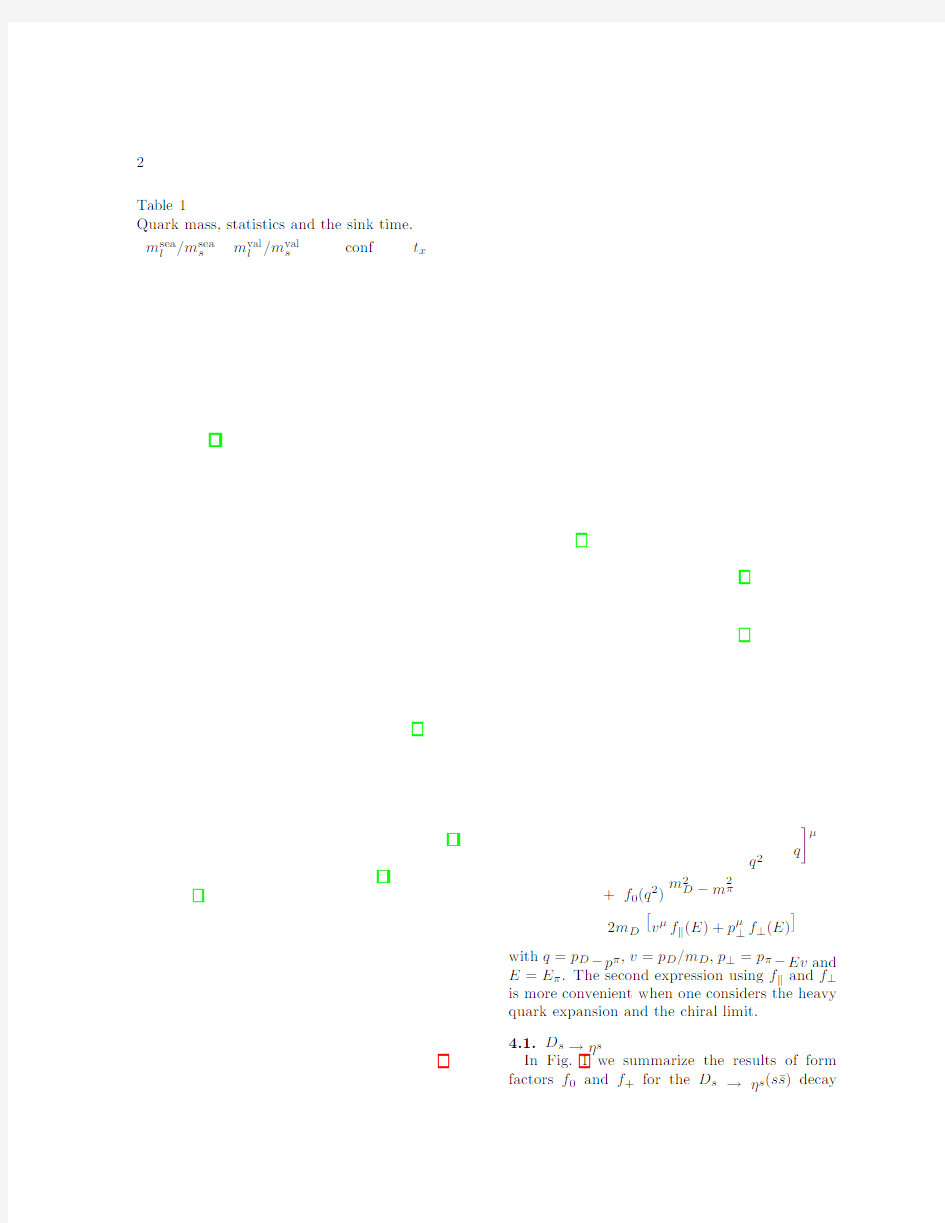Semileptonic decays of $D$ mesons in unquenched lattice QCD


a r X
i v :h e p -l a t /0309107v 1 16 S e p 2003
1
Semileptonic decays of D mesons in unquenched lattice QCD ?
Masataka Okamoto a ,Massimo di Pierro b ,Aida X.El-Khadra c ,Steven Gottlieb d ,Andreas S.Kronfeld a ,Paul B.Mackenzie a ,Damian P.Menscher c ,Mehmet B.Oktay c ,and James N.Simone a
a Fermi National Accelerator Laboratory,P.O.Box 500,Batavia,IL 60510
b
School of Computer Science,Telecommunications and Information Systems,DePaul University,Chicago,Illinois 60604
c
Department of Physics,University of Illinois,Urbana,IL 61801d
Department of Physics,Indiana University,Bloomington,IN 47405
We present our preliminary results for semileptonic form factors of D mesons in unquenched lattice QCD.Simulations are carried out with n f =2+1dynamical quarks using gauge con?gurations generated by the MILC collaboration.For the valence quarks,we adopt an improved staggered light quark action and the clover heavy quark action.Our results for D →K and D →πform factors at q 2=0are in agreement with the experimental values.
1.INTRODUCTION
In order to extract the CKM matrix element |V ub |accurately with experimental measurement of the semileptonic decay width,a precision lat-tice QCD calculation of the B →πform fac-tor is required.To check the reliability of lattice calculations of the heavy to light form factors,study of the semileptonic decays of D mesons,such as D →K and D →π,is a good test ground because the corresponding CKM matrices |V cs |and |V cd |are known more accurately than |V ub |.Furthermore,forthcoming experiments by the CLEO-c collaboration will provide more strin-gent checks of lattice calculations in the D meson system.
We have started new lattice calculations of heavy quark physics in unquenched QCD[1],and here we report our preliminary results for semilep-tonic form factors of D mesons.We are us-ing unquenched gauge con?gurations with n f =2+1improved staggered quarks generated by the MILC collaboration[2],with which the systematic errors due to the quenched approximation should be almost absent.For the valence light quarks,we adopt an improved staggered quark action,
C π2(t y ,p π)C
D 2
(t x ?t y ,p D )(2)
with the D meson (Wilson-Naive)2-point func-tion C D
2and the pion (Naive-Naive)2-point func-tion C π2.Care is needed,however,for the overall
2
Table1
Quark mass,statistics and the sink time. m sea l/m sea s m val l/m val s conf t x
q2q μ
+f
0(q2)
m2D?m2π
2m D vμf (E)+pμ⊥f⊥(E) with q=p D?pπ,v=p D/m D,p⊥=pπ?Ev and E=Eπ.The second expression using f and f⊥is more convenient when one considers the heavy quark expansion and the chiral limit.
4.1.D s→ηs
In Fig.1we summarize the results of form
factors f0and f+for the D s→ηs(sˉs)decay
3
(aE)
2
0.5
1
1.5
2
m l
0.2
0.40.6
0.811.21.4Figure 2.Chiral extrapolation for f D →π
⊥.
12
0.51
1.5
f 0
f +
experiment
D?>π
12
q 2 [GeV 2
]
0.5
1
1.5
f 0f +
experiment
D?>K
Figure 3.D →πand D →K form factors.obtained with the naive(staggered)light quarks and previous results[5]with the Wilson-type light quarks.The lines in the ?gure are ?tting curves with a parametrization by Becirevic and Kaidalov (BK)[6].One can see a nice agreement be-tween the quenched result with the naive quarks (squares,dashed line)and that with the Wilson-type quarks (circles,dotted),showing that our new method works well.We also note that the un-quenched result (diamonds,solid)is larger than quenched ones for q 2>0.See also Ref.[7]for a similar comparison for the B s →ηs form factors.4.2.D →πand D →K
To obtain D →π/K form factors at the phys-ical quark mass,we need to perform a chiral ex-trapolation using data in range of m val l
=0.01-0.03.We do this for f and f ⊥at ?xed pion(kaon)energies E π(K )because the chiral perturbation
formulas for the heavy to light form factors are
given in such a way[8].In order to interpolate and extrapolate the results to common values of E π,we use a ?t with the BK parametrization.We then perform a linear chiral extrapolation in m val l at nine values of (aE π)2.One example of these
procedures is shown in Fig.2for f D →π
⊥.Finally f and f ⊥are converted to f 0and f +.
The D →πand D →K form factors are shown in Fig.3together with experimental values at q 2=0[9].Our results at q 2=0are
f D →K +(0)=0.75(3),
f D →π
+
(0)=0.64(3)(3)
with statistical errors only,whereas experimental
values are f D →K +(0)=0.73(2)and f D →π
+(0)=0.73(13)with |V cs |=0.996(13)and |V cd |=0.224(16)[9].Our results are in agreement with the experimental values.The analysis including the chiral logarithm and the one-loop renormal-ization constant is underway.
Acknowledgments:We thank the MILC collab-oration for the use of their con?gurations,and the Fermilab Computing Division and the SciDAC program for their support.Fermilab is operated by Universities Research Association Inc.,under contract with the DOE.REFERENCES
1.See also,P.Mackenzie and J.Simone,these
proceedings.
2. C.Bernard et al.(MILC collaboration),Phys.
Rev.D 64,054506(2001).
3.M.Wingate et al.Phys.Rev.D 67,054505
(2003)
4. A.X.El-Khadra,A.Kronfeld and P.Macken-zie,Phys.Rev.D 55,3933(1997).
5. A.X.El-Khadra et al.Phys.Rev.D 64,
014502(2001)
6. D.Becirevic and A.B.Kaidalov,Phys.Lett.
B 478,417(2000)
7. C.DeTar,these proceedings.
8. D.Becirevic,S.Prelovsek and J.Zupan,
Phys.Rev.D 67,054010(2003)
9.K.Hagiwara et al.[Particle Data Group Col-laboration],Phys.Rev.D 66,010001(2002);C.Caso et al.Eur.Phys.J.C 3,1(1998).
